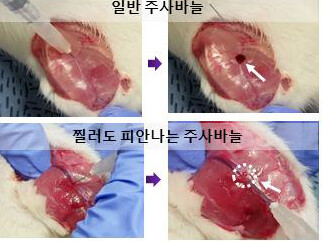hankyoreh
Links to other country sites 다른 나라 사이트 링크
A needle that doesn’t cause bleeding: South Korean researchers’ breakthrough

A research team at KAIST has created a hypodermic needle that will not make patients bleed.
After the needle was injected into an animal model with hemophilia, bleeding stopped, which does not happen with ordinary needles.
The research team, led by Lee Hae-sin, a chemistry professor at KAIST (Korea Advanced Institute of Science and Technology) announced the development on Oct. 6. The team explained that it had developed the needle using biomaterials that mimic the adhesive function of mussels. The team’s paper was published on the online edition of “Nature Materials” on Oct. 3.
When a patient receives an injection during medical treatment, bleeding can generally be stopped by pressing on the wound for about three minutes, but this does not work for people undergoing long-term hospitalization because of cancer and people suffering from hemophilia or diabetes. For such patients, a hemostatic coating can be applied to the needle, but this substance needs to stick to the skin and the inside of the blood vessels.
The research team developed this hemostatic substance by imitating how mussels use fibrous byssus (a tuft of strong fibers of scleroprotein secreted from the bodies of bivalves) to cling to rocks amid the crashing waves. Using adhesive chitosan containing catecholamine (a substance found in the structure of mussels’ byssus), researchers made a hemostatic film and placed this on hypodermic needles When this film comes into contact with blood, it instantaneously transforms into a hydrogel and stanches blood flow.
“Since the substance was found to be effective in the animal model with hemophilia, this is likely to be useful for patients with a disability that prevents blood from clotting,” Lee said.
Kang Seon-ung and Kim Gi-seok, researchers from the Korea Institute of Toxicology, also participated in the study.
By Lee Keun-young, senior staff writer
Please direct questions or comments to [english@hani.co.kr]

Editorial・opinion
![[Column] A rift in Korea’s ruling camp, made wider by its first lady [Column] A rift in Korea’s ruling camp, made wider by its first lady](https://flexible.img.hani.co.kr/flexible/normal/500/300/imgdb/original/2024/0708/9317204261622813.jpg) [Column] A rift in Korea’s ruling camp, made wider by its first lady
[Column] A rift in Korea’s ruling camp, made wider by its first lady![[Column] Korea and the return of Trump [Column] Korea and the return of Trump](https://flexible.img.hani.co.kr/flexible/normal/500/300/imgdb/original/2024/0708/9217204252680575.jpg) [Column] Korea and the return of Trump
[Column] Korea and the return of Trump- [Column] Is Korean democracy really regressing?
- [Column] How tragedy pervades weak links in Korean labor
- [Column] How opposing war became a far-right policy
- [Editorial] Korea needs to adjust diplomatic course in preparation for a Trump comeback
- [Editorial] Silence won’t save Yoon
- [Column] The miscalculations that started the Korean War mustn’t be repeated
- [Correspondent’s column] China-Europe relations tested once more by EV war
- [Correspondent’s column] Who really created the new ‘axis of evil’?
Most viewed articles
- 1Real-life heroes of “A Taxi Driver” pass away without having reunited
- 2[Column] Is Korean democracy really regressing?
- 3Former bodyguard’s dark tale of marriage to Samsung royalty
- 4Over 200,000 Koreans sign petition calling for deportation of Yemeni refugees in Jeju
- 5[Column] A rift in Korea’s ruling camp, made wider by its first lady
- 6Health care experts call on government to address problems with end of life legislation
- 7[Column] Korea and the return of Trump
- 8What will a super-weak yen mean for the Korean economy?
- 9Hong Myung-bo tapped to lead Korea’s national men’s football team once more
- 10Koreans are getting taller, but half of Korean men are now considered obese